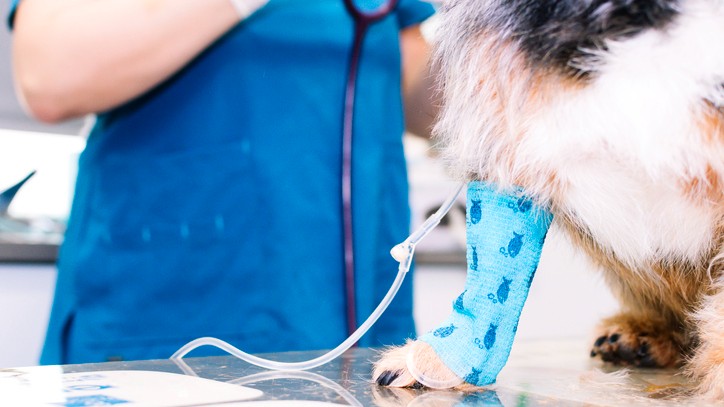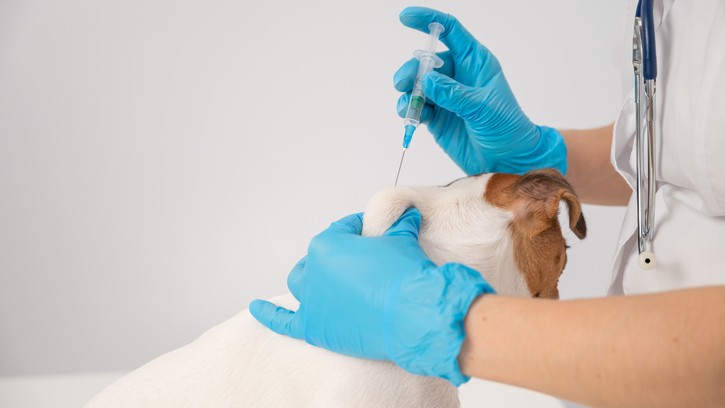Diabetic ketoacidosis in dogs: A vet’s guide
Diabetic ketoacidosis in dogs is a life-threatening medical emergency—keep reading to find out more about this condition in dogs.

Diabetic ketoacidosis is a serious complication of diabetes mellitus in dogs that can occur when glucose levels aren’t properly regulated. This condition requires prompt and aggressive treatment, and it is fatal when left untreated. Read on to learn more about diabetic ketoacidosis in dogs, including what it is and how it is managed in clinical practice.
What is diabetic ketoacidosis in dogs?
Diabetic ketoacidosis, or DKA, is characterized by high levels of ketones in the blood, affecting the body’s pH and making it more acidic. DKA occurs when a lack of insulin prevents glucose from being transported into the cells, resulting in elevated blood glucose levels. Since the cells are starved of their primary energy source (glucose), the body breaks down fat tissue to convert into fuel in the form of ketone bodies.
When diabetes in dogs goes unregulated, ketone bodies can accumulate in excessive levels that the body cannot process, so these ketones remain in the blood or are excreted in the urine. Elevated levels of ketones in the blood alter the normal acid/base balance and cause metabolic acidosis, which can lead to dehydration and electrolyte imbalances.
Causes of diabetic ketoacidosis in dogs
Most dogs diagnosed with DKA are newly diagnosed diabetics who have not undergone insulin therapy. Diabetic dogs who are experiencing stress are also prone to developing DKA because stress hormones like cortisol and adrenaline can counteract the effects of insulin. The following risk factors, as well as others, have the potential to cause DKA in dogs:
Uncontrolled diabetes
A dog’s diabetes may not be under control if they are newly diagnosed or if their dose of insulin is too low, allowing ketones to build up in the body.
Pancreatitis
Pancreatitis in dogs can destroy the beta cells of the pancreas, which produce and store insulin, thus resulting in a lack of insulin.
Infection
Urinary tract infections are common in dogs with unregulated diabetes and can increase inflammation and stress hormones in the body. Other infections can have the same effect.
Cushing’s disease
Cushing’s disease is characterized by excessive levels of cortisol, which directly counteracts insulin.
Cancer
Certain cancers can either release stress hormones themselves or induce the release of stress hormones that act against insulin.
Certain drugs
Steroids and some hormone therapies can counteract insulin and increase the risk of DKA. These medications should be avoided or given with caution in diabetic dogs.
Symptoms of diabetic ketoacidosis in dogs
The symptoms of DKA typically present over hours to days and include:
- Increased thirst
- Increased urinations
- Unintended weight loss
- Vomiting
- Lethargy
- Weakness
- Increased respiratory rate
- Alterations in heart rate or rhythm
- Dehydration
- Unkempt coat
- Muscle wasting
- Sweet-smelling breath
- Collapse
If your dog is showing any signs of DKA, you should seek veterinary attention immediately.
Diagnosis of diabetic ketoacidosis in dogs
Diagnosing DKA in dogs involves obtaining a full clinical history, performing a thorough physical examination, and running diagnostic tests such as blood and urine tests. Common findings include high levels of ketones and glucose in the blood and urine, signs of metabolic acidosis, and electrolyte abnormalities.
The veterinarian may recommend further diagnostic tests, such as additional bloodwork and imaging, to search for coexisting diseases that may have contributed to the development of DKA. A study conducted by Hume et al. on 127 dogs with DKA found that 69% of them were diagnosed with at least 1 other disorder at the time of hospitalization for DKA, the most common being acute pancreatitis, urinary tract infection, and Cushing’s disease.

Treatment of diabetic ketoacidosis in dogs
The initial treatment of DKA in dogs is aggressive and requires hospitalization with frequent monitoring (every 1-2 hours). Your vet may wish to refer you to a specialist center with more resources and the ability to provide around-the-clock care.
Once a dog has been admitted to the hospital, the first goal of treatment is to reverse dehydration with intravenous fluid therapy. Dogs with electrolyte abnormalities may require supplementation or adjustment of fluids to correct these derangements. Once a dog has been stabilized, short-acting insulin therapy can be initiated to encourage glucose uptake by the cells and allow ketone levels to fall. Some dogs may also require additional treatment for underlying disease processes or for metabolic acidosis if it does not resolve with fluids and insulin therapy.
Dogs with DKA are hospitalized until they are bright and willing to eat and drink on their own. Routine stabilization of diabetes mellitus with subcutaneous insulin injections is then started. All dogs should be treated as new diabetics, regardless of when they were diagnosed, so they should be given a low insulin dose and monitored frequently while their owner stays in close contact with their vet to adjust the insulin dose as required.
How long does it take a dog to recover from diabetic ketoacidosis?
The previously mentioned study on dogs with DKA found that the median hospitalization time was 6 days, and this was affected by the presence of coexisting diseases and electrolyte abnormalities. Owners should also consider the amount of time it will take to get their dog’s diabetes under control once they are back home, which can take several months in some cases.
Before pursuing treatment, it is important that owners are aware that hospitalization for DKA may take several days and can quickly become costly. Pet insurance is recommended to help alleviate the costs of unexpected medical conditions such as DKA.
Prognosis of diabetic ketoacidosis in dogs
The study by Hume et al. found that 70% of the dogs with DKA survived. Several factors can influence prognosis, including disease severity, response to treatment, and the presence of coexisting diseases. There is also the possibility of recurrence in dogs with unstable diabetes or underlying conditions that have not been addressed.
Due to the seriousness of DKA, it is preferable to prevent it from developing in the first place. Diabetic dogs’ blood glucose levels should be regularly monitored at home using a glucometer, with their insulin dose adjusted according to their vet’s recommendation. In dogs who have not been diagnosed with diabetes but are showing signs of it, they should be taken to their vet as soon as possible for investigation.
PetsRadar Newsletter
Get the best advice, tips and top tech for your beloved Pets
Dr. Diana Hasler graduated with distinction from the University of Edinburgh Royal (Dick) School of Veterinary Studies in 2018. She has experience working as a small animal veterinarian in general practice, where she has treated many dogs, cats, rabbits, and rodents. She has also recently branched out into the field of medical communications, doing freelance work as a medical editor and writer. Dr. Hasler currently lives in Edinburgh where she enjoys spending time with her husband Gavin and playing with their feisty tabby cat Poppy.

